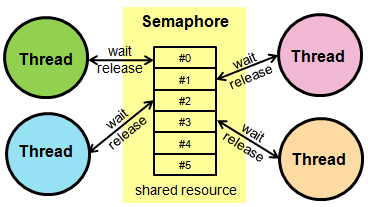 |
CMSIS-RTOS RTX
Version 4.80
CMSIS-RTOS RTX: Real-Time Operating System for Cortex-M processor-based devices
|
 |
CMSIS-RTOS RTX
Version 4.80
CMSIS-RTOS RTX: Real-Time Operating System for Cortex-M processor-based devices
|
Control access to shared resources. More...
Macros | |
| #define | osFeature_Semaphore 65535 |
| Maximum count for osSemaphoreCreate function. | |
| #define | osSemaphoreDef(name) |
| Define a Semaphore object. | |
| #define | osSemaphore(name) &os_semaphore_def_##name |
| Access a Semaphore definition. | |
Functions | |
| osSemaphoreId | osSemaphoreCreate (const osSemaphoreDef_t *semaphore_def, int32_t count) |
| Create and Initialize a Semaphore object used for managing resources. | |
| int32_t | osSemaphoreWait (osSemaphoreId semaphore_id, uint32_t millisec) |
| Wait until a Semaphore token becomes available. | |
| osStatus | osSemaphoreRelease (osSemaphoreId semaphore_id) |
| Release a Semaphore token. | |
| osStatus | osSemaphoreDelete (osSemaphoreId semaphore_id) |
| Delete a Semaphore that was created by osSemaphoreCreate. | |
The Semaphore Management function group is used to manage and protect access to shared resources. For example, with a Semaphore the access to a group of identical peripherals can be managed. The number of available resources is specified as parameter of the osSemaphoreCreate function.
Each time a Semaphore token is obtained with osSemaphoreWait the semaphore count is decremented. When the semaphore count is 0, no Semaphore token can be obtained. Semaphores are released with osSemaphoreRelease; this function increments the semaphore count.

| #define osFeature_Semaphore 65535 |
CMSIS-RTOS RTX supports an index count up to 65535 for a semaphore .
| #define osSemaphore | ( | name | ) | &os_semaphore_def_##name |
Access to semaphore object for the functions osSemaphoreCreate.
| name | name of the semaphore object. |
| #define osSemaphoreDef | ( | name | ) |
Define a semaphore object that is referenced by osSemaphore.
| name | name of the semaphore object. |
| osSemaphoreId osSemaphoreCreate | ( | const osSemaphoreDef_t * | semaphore_def, |
| int32_t | count | ||
| ) |
| [in] | semaphore_def | semaphore definition referenced with osSemaphore. |
| [in] | count | number of available resources. |
Create and initialize a Semaphore object that is used to manage access to shared resources. The parameter count specifies the number of available resources. The count value 1 creates a binary semaphore.
Example
| osStatus osSemaphoreDelete | ( | osSemaphoreId | semaphore_id | ) |
| [in] | semaphore_id | semaphore object referenced with osSemaphoreCreate. |
Delete a Semaphore object. The function releases internal memory obtained for Semaphore handling. After this call the semaphore_id is no longer valid and cannot be used. The Semaphore may be created again using the function osSemaphoreCreate.
| osStatus osSemaphoreRelease | ( | osSemaphoreId | semaphore_id | ) |
| [in] | semaphore_id | semaphore object referenced with osSemaphoreCreate. |
Release a Semaphore token. This increments the count of available semaphore tokens.
| int32_t osSemaphoreWait | ( | osSemaphoreId | semaphore_id, |
| uint32_t | millisec | ||
| ) |
| [in] | semaphore_id | semaphore object referenced with osSemaphoreCreate. |
| [in] | millisec | Timout Value or 0 in case of no time-out. |
Wait until a Semaphore token becomes available. When no Semaphore token is available, the function waits for the time specified with the parameter millisec.
The argument millisec specifies how long the system waits for a Semaphore token to become available. While the system waits the thread that is calling this function is put into the state WAITING. The millisec timeout can have the following values:
The return value indicates the number of available tokens (the semaphore count value). If 0 is returned, then no semaphore was available.